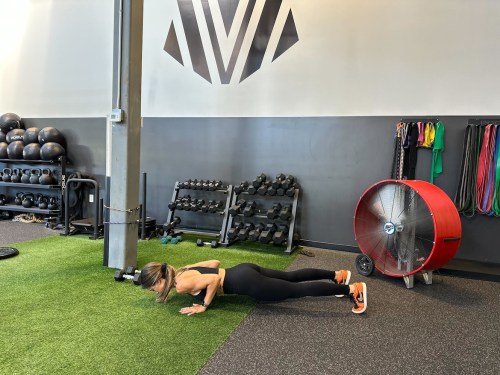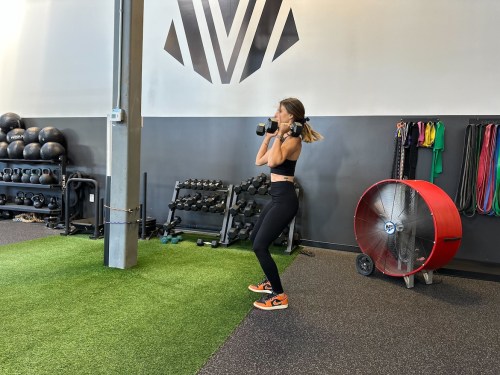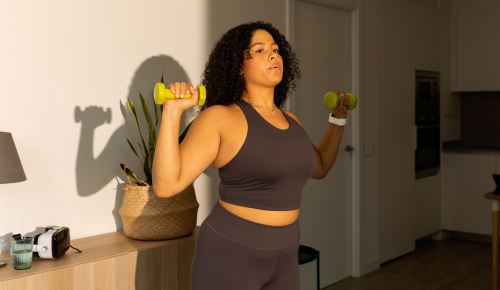When you first hear “circuit training,” it may sound somewhat complicated. However, it’s actually a very straightforward way to improve your endurance and strength.
Experts in This Article
certified personal trainer and clinical athlete-certified weightlifting coach for BarBend
a certified personal trainer and district fitness manager at 24 Hour Fitness
a certified personal trainer and co-founder and president of fitness at VICTRESS MVMT, a fitness training facility in Lincoln, Nebraska
Circuit training workouts incorporate a variety of exercises that can be tailored to practically any fitness level. What’s more, they may help you combine two workouts into one for a more efficient session (all while keeping your boredom at bay).
Here’s everything you need to know about circuit training, plus a sample workout to try.
What is circuit training?
Circuit training is a sequence of exercises performed with minimum rest between each one.
“Each exercise targets different muscle groups, providing a comprehensive workout that combines both strength training and cardiovascular conditioning,” says Laurie Nielsen-Consiglieri, CPT, a certified personal trainer and district fitness manager at 24 Hour Fitness.
In other words, circuit training is really about how you structure your workouts, rather than any one particular type of exercise. In circuit training, you’ll do each move for a certain number of reps or amount of time, then quickly move on to the next exercise.
“Because it’s so fast-paced, you can usually get a great workout done in about 30 to 45 minutes,” says Josh York, CPT, a certified personal trainer and founder and CEO of GYMGUYZ, a personal training company.
Circuit training benefits
That time efficiency is one reason many people love circuit workouts, which can still help you get the combined benefits of both strength training and aerobic exercise in less time.
“You can get a solid workout in a fraction of the time it would take you to perform a complete weight-lifting routine or cardio workout separately,” says Jake Dickson, CPT, a certified personal trainer at Barbend.
Circuit training can easily be customized to fit various fitness levels and goals—and can be done with or without equipment.
This type of workout also has several health benefits, says Nielsen-Consiglieri, such as:
- Improving cardiovascular health
- Increasing strength and muscle tone
- Enhancing metabolism
- Boosting endurance and stamina
- Providing a full-body workout
In fact, those who did circuit-based training saw more improvements in strength, cardiorespiratory fitness, and body composition (decreased fat mass) compared to control groups in a 2021 review in the journal Biology1.
Circuit training workouts incorporate a variety of exercises that can be tailored to practically any fitness level. What’s more, they may help you combine two workouts into one for a more efficient session.
Circuit training drawbacks
Because circuit training involves high-intensity movements with minimal rest, it can sometimes lead to muscle strains or sprains. It’s important to listen to your body throughout the workout.
“The biggest drawback of circuit training is that it may not allow for sufficient recovery time between exercises,” says Stacy Orsborn, CPT, a certified personal trainer and co-founder and president of fitness at VICTRESS MVMT, a fitness training facility in Lincoln, Nebraska.
As a result, circuit training may lead to fatigue, which can compromise form and increase the risk of injury—particularly for beginners, women in certain stages of life like perimenopause or postmenopause, or those with already high levels of stress in their daily lives, Orsborn says.
Circuit training is also not a quick fix for many specific fitness goals.
“While it’s great for general fitness, it might not be the best choice if you have specific goals, such as achieving a certain level of strength or training for a marathon,” Nielsen-Consiglieri says.
Finally, circuit training can eventually result in you plateauing if you don’t introduce enough variety into your workouts.
“Doing the same circuit repeatedly can lead to your body adapting, which might slow your progress,” York says. “To keep seeing improvements, try mixing up your routine and adding new challenges.” (In case you’re wondering, here’s how often to switch up your workout routine.)
Does circuit training count as cardio?
Yes, because you’re moving quickly from one exercise to another with minimal rest.
“This can elevate your heart rate and provide cardio benefits,” Nielsen-Consiglieri says.
Also known as aerobic or endurance exercise, you can think of cardio as anything that boosts your heart rate or gets you breathing a little harder, per Harvard Medical School.
Although exercises like running, swimming, dancing, or hiking are traditionally thought of as cardio staples, circuit training also counts, since the sustained high effort elevates your heart rate throughout the workout, Dickson adds.
Does circuit training count as strength training?
It can, but it depends on what type of resistance exercises it incorporates.
“When a circuit incorporates resistance exercises like push-ups, squats, lunges, or weightlifting movements, it can build strength and muscle tone,” Nielsen-Consiglieri says.
The effectiveness of circuit training for strengthening will depend on the specific exercises, resistance levels, and structure of the workout.
“While it can be less physically demanding than other resistance training, circuit training can still assist in building stronger muscles,” York says. “The circuit can be designed to target your upper body, lower body, and core, for instance.”
Is circuit training the same as HIIT?
Not quite: While both involve interval training with rest, there are key differences.
“One of the biggest differences is that circuit training can be performed at various intensities, whereas HIIT [high-intensity interval training] requires your full effort, with the goal of hitting 80 to 90 percent of your maximum heart rate,” York says.
Circuit training rotates through a series of moderate-intensity exercises that target different muscle groups with almost no rest between each one. HIIT, on the other hand, can involve a single exercise or multiple ones that are performed at maximum intensity for short intervals, followed by rest.
The structure of intervals is another difference, York adds. Circuit training can be based on either time or repetition intervals (say, completing an exercise for 30 seconds or completing an exercise 10 times). HIIT, on the other hand, tends to focus more exclusively on time intervals.
A sample circuit workout to add to your routine
For a quick circuit training workout at home, try this routine designed by Orsborn.
Perform each exercise for 45 seconds, followed by 15 seconds of rest before moving to the next exercise (that counts as one round). Complete four rounds total, resting for one to two minutes between rounds.
1. Dumbbell squat

- 1.Hold a dumbbell in each hand at shoulder height, with feet shoulder-width apart.
- 2.Bend your knees as you push your hips back to lower toward the floor, pretending you were going to sit on a chair.
- 3.Lower down as far as comfortable, or until your thighs are parallel with the floor.
- 4.Make sure your knees track over your toes throughout the movement.
- 5.Drive through your heels to return to standing.
- 6.Repeat.
2. Push-up

- 1.Begin in a high plank position with your hands slightly wider than shoulder-width apart. Your body should form a straight line from your head to your heels.
- 2.Bend your elbows at a 45-degree angle to your body and lower your chest to the floor (or as close as possible), keeping your body in a straight line.
- 3.Push through your hands back up to the starting position. Keep your core tight and exhale on your way up.
- 4.Repeat.
3. Renegade row

- 1.Place two dumbbells slightly closer than shoulder-width apart on the ground.
- 2.Grip each dumbbell and come into a high plank, shoulders stacked over hands, feet slightly wider than hip-width apart and your body in a straight line from head to heels.
- 3.Lift your left hand off the floor, pulling the dumbbell to the top of your ribcage.
- 4.Lower your left hand back onto the floor in starting position.
- 5.Lift your right hand off the floor, pulling the dumbbell to the top of your ribcage.
- 6.Lower your right hand back onto the floor in starting position.
- 7.Continue alternating for all reps.
4. Dumbbell lunge

- 1.Hold a dumbbell in each hand at your sides (palms facing in), your feet hip-width apart.
- 2.Step your left foot forward, then bend both knees and lower them toward the floor with control.
- 3.Keep lowering until your back knee is about an inch off the ground (or as low as comfortable).
- 4.Push through your front heel to return to standing.
- 5.Repeat on opposite leg.
5. Dumbbell push press

- 1.Hold a dumbbell in each hand at shoulder height, with feet shoulder-width apart.
- 2.Dip your lower-body slightly by bending your knees, then explosively press the dumbbells overhead (using your legs to help drive the weight up).
- 3.Exhale as you drive overhead and straighten your knees.
- 4.Return the dumbbells to your shoulders.
- 5.Repeat.
6. Glute bridge

- 1.Lie on your back with your knees bent and feet flat on the floor, arms down by your sides.
- 2.Lift your hips by squeezing your glutes, creating a straight line from shoulders to knees.
- 3.Lower back down with control.
- 4.Repeat.
“If you are someone that likes to move around constantly, circuit training would provide a great alternative to a traditional one-exercise-at-a-time workout.” —Josh York, CPT
Who circuit training is best for
Circuit training can be a good fit for a variety of people, especially since it can be tailored to your unique goals. According to Nielsen-Consiglieri, this can include:
- Beginners
- Busy, time-strapped individuals
- Those who want to improve general fitness
- People with limited equipment or space
- Athletes or fitness enthusiasts
It’s also a great option if you tend to get bored easily.
“If you are someone that likes to move around constantly, circuit training would provide a great alternative to a traditional one-exercise-at-a-time workout,” York says.
Safety tips
Before you dive into a circuit training workout, make sure you warm up properly to increase your body temperature, boost your blood flow, and loosen your muscles. York recommends five to 10 minutes of dynamic warmups, such as jumping jacks, light jogging, or arm circles.
Next, get your equipment and space in order. Circuit training is already intense, so there’s no need to push beyond your limits when it comes to the weights you’re using (if your workout includes equipment).
Also make sure you have enough room to do the various exercises in your circuit. “You don’t want to feel cramped in the middle of your session, or risk injury by bumping into another gym-goer,” Dickson says.
Because of the intensity and lack of breaks with circuit training, it’s key to watch your form (focus on this over weight or reps) and slow down as needed. Don’t be hard on yourself if you end up needing to take a longer break during your circuit training. Also look out for signs that you may have pushed yourself too far.
“This can be an intense workout—and feeling dizzy, nauseous or weak can be a sign of overdoing it,” York says. “If you feel any of these, you should immediately stop the workout.”
Finally, while it’s important to stay hydrated during any workout, circuit training can get especially sweaty (and, as a result, dehydrating). Drink water before rounds to restore your fluid levels.
Ramos-Campo DJ, Andreu Caravaca L, Martínez-Rodríguez A, Rubio-Arias JÁ. Effects of Resistance Circuit-Based Training on Body Composition, Strength and Cardiorespiratory Fitness: A Systematic Review and Meta-Analysis. Biology (Basel). 2021 Apr 28;10(5):377. doi: 10.3390/biology10050377. PMID: 33924785; PMCID: PMC8145598.
↩︎
Sign Up for Our Daily Newsletter
Get all the latest in wellness, trends, food, fitness, beauty, and more delivered right to your inbox.
Got it, you've been added to our email list.











